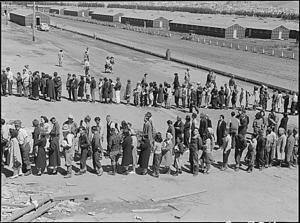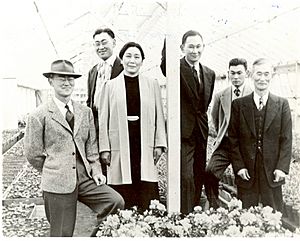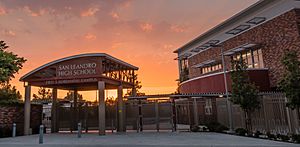Fred Korematsu facts for kids
Quick facts for kids
Fred Korematsu
是松豊三郎 |
|
|---|---|
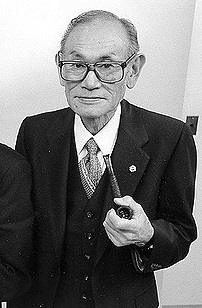 |
|
| Born |
Fred Toyosaburo Korematsu
January 30, 1919 Oakland, California, U.S.
|
| Died | March 30, 2005 (aged 86) Marin County, California, U.S.
|
| Resting place | Mountain View Cemetery |
| Monuments |
|
| Alma mater | Castlemont High School |
| Known for | Korematsu v. United States |
| Spouse(s) |
Kathryn Pearson
(m. 1946) |
| Children | 2 |
| Awards | Presidential Medal of Freedom (1998) |
Fred Toyosaburo Korematsu (是松豊三郎, Korematsu Toyosaburo, January 30, 1919 – March 30, 2005) was an American civil rights activist.
Early life
Fred Toyosaburo Korematsu was born in Oakland, California, on January 30, 1919. He was the third of four sons to Japanese parents Kakusaburo Korematsu and Kotsui Aoki. Korematsu played for the Castlemont High School (Oakland, California) school tennis team, and worked in his family's flower nursery in nearby San Leandro, California.
World War II
During World War II, Korematsu was called for military duty, but was formally rejected by the U.S. Navy due to stomach ulcers. He trained to become a welder in order to contribute his services to the defense effort. First, he worked as a welder at a shipyard. He went in one day to find his timecard missing; his coworkers hastily explained to him that he was Japanese so therefore he was not allowed to work there. He then found a new job, but was fired after a week when his supervisor returned from an extended vacation to find him working there. Because of his Japanese descent, Korematsu lost all employment completely following the attack on Pearl Harbor.
On March 27, 1942, General John L. DeWitt, commander of the Western Defense Area, prohibited Japanese Americans from leaving the limits of Military Area No. 1, in preparation for their eventual evacuation to internment camps. Korematsu underwent plastic surgery on his eyelids in an unsuccessful attempt to pass as a Caucasian, changed his name to Clyde Sarah and claimed to be of Spanish and Hawaiian heritage.
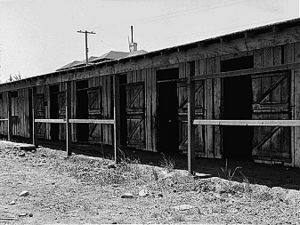
When on May 3, 1942, General DeWitt ordered Japanese Americans to report on May 9 to Assembly Centers as a prelude to being removed to the internment camps, Korematsu refused and went into hiding in the Oakland area. He was arrested on a street corner in San Leandro on May 30, 1942, and held at a jail in San Francisco. Shortly after Korematsu's arrest, Ernest Besig, the director of the American Civil Liberties Union in northern California, asked him whether he would be willing to use his case to test the legality of the Japanese American internment. Korematsu agreed because he felt that "people should have a fair trial".
On September 8, 1942, Korematsu was tried and convicted in federal court for a violation of Public Law No. 503 and was placed on five years' probation. He and his family were placed in the Central Utah War Relocation Center in Topaz, Utah. As an unskilled laborer, he received only $12 per month (equivalent to $214.92 in 2022) for working eight-hour days at the camp. He was placed in a horse stall with a single light bulb, and later said "jail was better than this".
When Korematsu's family was moved to the Topaz internment camp, his imprisoned compatriots recognized him and many, if not most, of them felt that if they talked to him they would also be seen as troublemakers.
Korematsu appealed to the U.S. Court of Appeals, which granted review on March 27, 1943, but upheld the original verdict. He appealed again and brought his case to the United States Supreme Court, which granted review on March 27, 1944. On December 18, 1944, in a 6–3 decision authored by Justice Hugo Black, the Court held that compulsory exclusion, though constitutionally suspect, was justified during circumstances of "emergency and peril".
Later adult life and compensation
After being released from the camp in Utah, Korematsu had to move east since the law would not allow former internees to move back westward. He moved to Salt Lake City, Utah, where he continued to fight racism. He found work repairing water tanks in Salt Lake City, but after three months on the job, he discovered he was being paid half of what his white coworkers were being paid. He told his boss that this was unfair and asked to be paid the same amount, but his boss only threatened to call the police and try to get him arrested just for being Japanese, so he left his job. After this incident, Korematsu lost hope, remaining quiet for over thirty years.
He moved to Detroit, Michigan, where his younger brother lived, and where he worked as a draftsman until 1949. He married Kathryn Pearson in Detroit on October 12, 1946. They returned to Oakland to visit his family in 1949 because his mother was ill. They did not intend to stay, but decided to after Kathryn became pregnant with their first child, Karen. His daughter was born in 1950, and a son, Ken, in 1954.
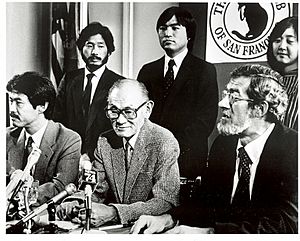
In 1976, President Gerald Ford signed a proclamation formally terminating Executive Order 9066 and apologizing for the internment. In 1980, President Jimmy Carter appointed a special commission to investigate the internment of Japanese Americans during World War II, which concluded that the decisions to remove those of Japanese ancestry to prison camps occurred because of "race prejudice, war hysteria, and a failure of political leadership". In 1988, President Ronald Reagan signed the Civil Liberties Act of 1988, which provided financial redress of $20,000 for each surviving detainee, totaling $1.2 billion.
In the early 1980s, lawyer and University of California, San Diego professor Peter Irons along with a team of lawyers headed by Dale Minami petitioned to overturn Korematsu's conviction. On November 10, 1983, Judge Marilyn Hall Patel of U.S. District Court in San Francisco formally vacated the conviction. Korematsu testified before Judge Patel, "I would like to see the government admit that they were wrong and do something about it so this will never happen again to any American citizen of any race, creed, or color." He also said, "If anyone should do any pardoning, I should be the one pardoning the government for what they did to the Japanese-American people." Irons described Korematsu's ending statement during the case as the most powerful statement he'd ever heard from anyone. He found the statement as empowering as Martin Luther King Jr.'s 1963 "I Have a Dream" speech. Judge Patel's ruling cleared Korematsu's name, but was incapable of overturning the Supreme Court's decision.
In 1998, Korematsu was awarded the Presidential Medal of Freedom, the highest civilian honor in the United States.
A member and Elder of the First Presbyterian Church of Oakland, Korematsu was twice President of the San Leandro Lions Club, and for 15 years a volunteer with Boy Scouts of America, San Francisco Bay Council.
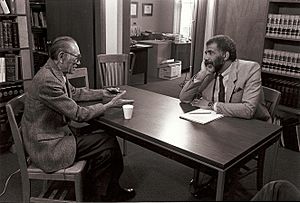
From 2001 until his death, Korematsu served on the Constitution Project's bipartisan Liberty and Security Committee. In 2004, he warned, "No one should ever be locked away simply because they share the same race, ethnicity, or religion as a spy or terrorist. If that principle was not learned from the internment of Japanese Americans, then these are very dangerous times for our democracy."
Death
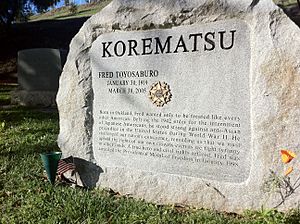
Fred Korematsu died of respiratory failure at his daughter's home in Marin County, California, on March 30, 2005. Korematsu was buried at the Mountain View Cemetery.
Legacy
The Fred T. Korematsu Institute carries Korematsu's name to continue his work with teachers and community leaders across the country to promote Korematsu's fight for justice and civil liberties.
The Fred T. Korematsu Center for Law and Equality at the Seattle University School of Law "advance[s] justice and equality through research, advocacy, and education" and houses The Defender Initiative and the Homeless Rights Advocacy Project.
Other dedications and honors include the following:
- Fred T. Korematsu Elementary School at Mace Ranch in Davis, California, is named for Korematsu.
- The auxiliary campus at San Leandro High School is named the Fred T. Korematsu Campus in honor of Korematsu.
- The Discovery Academy elementary school in Oakland, California, was renamed Fred T. Korematsu Discovery Academy.
- Portola Middle School was renamed The Fred T Korematsu Middle School in El Cerrito, California, at the new campus location formerly Castro Elementary School site.
- In 1988, a street in San Jose, California was renamed Korematsu Court.
- There is a Korematsu bronze relief in front of the San Jose Federal Building.
- Awards in his name include the Alameda County Bar Association's ABA Liberty Bell Award and the American Muslim Voices Korematsu Civil Rights Award.
- On September 23, 2010, Governor Arnold Schwarzenegger of California signed into law a bill that designates January 30 of each year as the Fred Korematsu Day of Civil Liberties and the Constitution, a first for an Asian American in the United States. It was observed for the first time on January 30, 2011. The main celebration of the California state was held at the Wheeler Auditorium on the University of California, Berkeley campus, sponsored by the Korematsu Institute, a non-profit program co-founded by Korematsu's daughter Karen Korematsu to advance racial equity, social justice, and human rights as well as the Asian Law Caucus, a San Francisco-based civil rights organization. The event included presentations by the Rev. Jesse Jackson and a screening of the Emmy Award-winning film Of Civil Wrongs and Rights: The Fred Korematsu Story.
- In 2015, the Commonwealth of Virginia established January 30 as "Fred Korematsu Day of Civil Liberties and the Constitution" beginning in 2016.
- Since 2010, Hawaii, Utah, Georgia, Illinois, Pennsylvania, South Carolina, Michigan and Florida have all commemorated "Fred Korematsu Day of Civil Liberties and the Constitution".
- Korematsu was the first Asian American featured in "The Struggle for Justice", a permanent exhibition at the Smithsonian's National Portrait Gallery.
- On January 30, 2017, to commemorate what would have been his 98th birthday, Korematsu was honored with a front-page Google Doodle.
- On December 19, 2017, the New York City Council unanimously passed a resolution establishing January 30 annually as Fred T. Korematsu Day of Civil Liberties and the Constitution. The resolution's main sponsor was Council Member Daniel Dromm of Queens.
- On October 27, 2021, Korematsu posthumously received the Freedom Medal from the Roosevelt Institute.
See also


